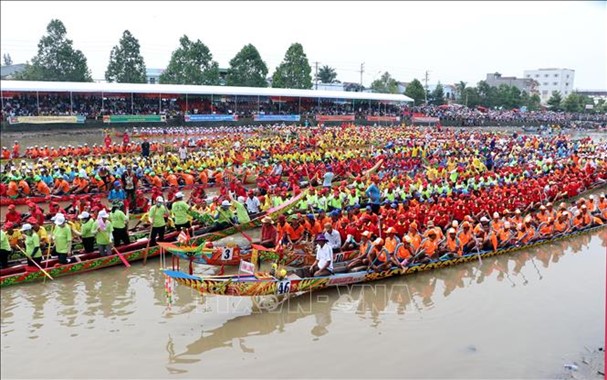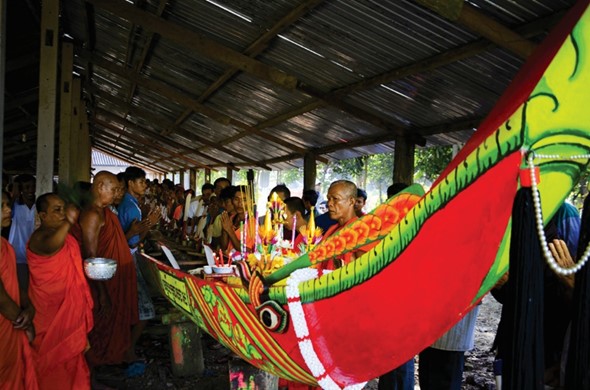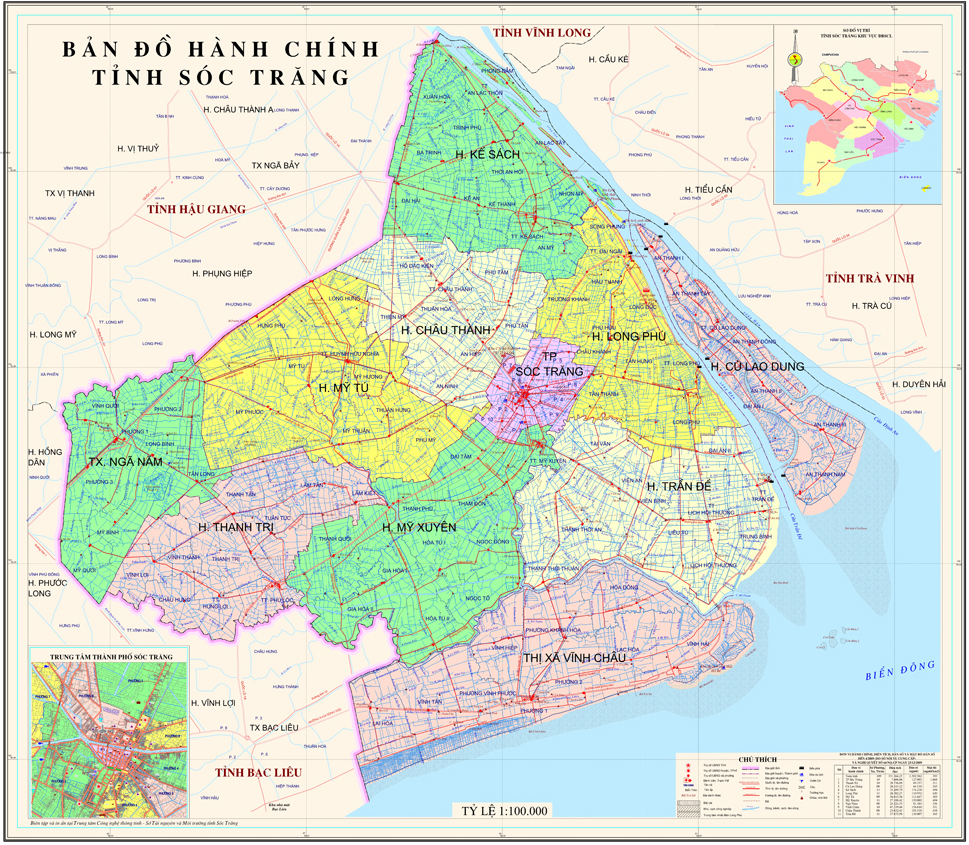The process of forming and developing Ngo boat race in Soc Trang
06/04/2022
Listening to the accompaniment songs, although rustic, but deeply rooted in people's hearts "Hay do do hay do mon ..." is the sacred call of the traditional festival that every Khmer citizen knows. This is the signal of the traditional festival of Ngo boat race of the Khmer people in Soc Trang in particular and the Khmer people in the Mekong Delta in general, which usually takes place on the days 14 th , 15 th of Ka -dath month, on f ull moon day of October of the Vietnamese lunar calendar respectively.
In 2013, the festival was held on a different scale compared to other years, with the permission of the Prime Minister, Soc Trang organized the "First Ngo Boat Race Festival of the Khmer people in the Mekong Delta - Soc Trang province in 2013". It was good news because of a cultural event with a large community nature at the regional - national level that was a joyful festival of solidarity, creation of ethnic cultural and sport values of people in Mekong Delta.
About Khmer Ngo Boat Race festival, we don't really know when it started? How did it originate and develop? So far, there is still a mystery about its origin, with no clear and satisfactory answer. Fortunately, there are also some documents, which are not many, but are very necessary and an important basis for research on this festival.
According to legend, there are many theories about Ngo boat racing. But among them, there are 3 theories that deserve the most attention, which are: First, according to folklore, there was a princess Neng Chanh (Nang Chanh) who had perfect talent and was loved by the king. Out of jealousy, a mandarin falsely accused her of putting dirt in her fingernails into the king's soup. Knowing that she had no way to prove her innocence, Neng Chanh quickly got into the boat down the Ba Sac River to escape. The king sent his soldiers to chase and kill her. Knowing that she could not escape, her fate in arrangement, so Neng Chanh hurriedly threw the spittoon (the Khmer people called it Kon tho) which was a souvenir given by the king into the river where the Khmer later called it "Peam Kon tho" (Peam is Vam, Kon Tho is a spittoon; Vietnamese call Vam Ong Nho - now called Vam Du Tho) and in the end she was tragically executed by the king. From that legend, it is said in Khmer folklore: to commemorate Neng Chanh's talent and fate, every year Khmer residents around the region organize Ngo boat race to reenact the scene of Neng Chanh fleeing from the palace to the land of Ba Sac - Soc Trang nowadays.
Secondly, the custom of Ngo boat racing according to folklore was derived from the living characteristics of the community in the river area at that time, so at first they built a dugout boat to use as a means of transportation. At the same time, the Ngo boat was also a sacred object that used the Ngo boat to bring water from the fields to the sea, marking the end of a farming year. The livelihoods fighting with nature and wild animals were often organized in groups, so the dugout boat at that time was somewhat inconvenient, unable to meet the capacity of many people as required. So they had to take the initiative to build a long boat to carry many people, serving the livelihood of the community.
Third, there is a theory that Ngo boat racing custom of Khmer people is to review the miracles of the main force of navy and battle boat (the Ngo boat). According to a document written recently in Khmer language, the "Origin of Ngo boat race festival, releasing water lamps and worshiping the moon" by monk Thach So Tum published in 2009 is also worth pondering over the history of this traditional festival. In it, it was mentioned about the origin of Ngo boat race festival in Soc Trang that: Ngo boat race festival has existed for a long time and became a custom of the inhabitants of the ancient land of Ba Sac (Soc Trang now) around the year 2071 according to the Buddhist calendar and the year 1528 according to the solar calendar, corresponding to the era of the first Ang Chanh King, the Long wek dynasty of Cambodia (Pages four and five).
According to legend, the Ngo boat racing custom of the Khmer people in Soc Trang was first held in "Peam Kon Tho" which is Vam Du Tho now in My Xuyen district, Soc Trang province. Here, the Ngo boat crews of Bac Lieu, Kien Giang and Tra Vinh regions gather conveniently. There is a large straight river here, the water flows evenly, an open ground yard and also a junction where became a busy trading place at that time.
During the French colonial period, they were forced to move the racing point to the Om Pu Gie River, which is Nhu Gia River now, in Thanh Phu Commune, My Xuyen District, Soc Trang Province to facilitate security control. During the American puppet era, the race was also held at the Nhu Gia River, sometimes (1972-1974) organized at Kinh Sang, Soc Trang city now. After the liberation of the South, the Ngo boat race was held on Nhu Gia River until about the early 80s. In order to organize the traditional Ngo boat race of the Khmer ethnic group more and more thoughtfully, promoting the cultural values of Khmer people, modernization and popularity of the festival, the race was officially moved to be held at Kinh Sang, also known as the Sung Dinh river, called the Maspero river (Soc Trang city) in the French colony time in the center of Soc Trang province until now. Every year, the organizing scale of the race is getting bigger and bigger, clearly showing the massization of the festival in the direction of civilized beauty, solidarity and safety for the purpose of improving the enjoyment of the spiritual cultural life for ethnic minorities in particular and people in the province and in the region in general.
"Tuk Ngo" (Ngo boat) has the original structure as a dugout boat, made of Golden oak tree. Once upon a time, the forests of the Mekong Delta were full of precious wood. However, to find a golden oak tree trunk equal to two people's hug is not an easy task. They must organize for a group of people to go to the forest to find suitable trees despite wild animals and snakes. When finding the right standard tree, people had to make offerings to the forest god (Neak ta Prey ph'nom) to be safe and then cut down the tree. They had to use the strength of buffalo or elephant to pull the tree into the river, built a raft and released it along the water. The Golden oak tree brought back must be sawed, chiseled, hewn and carved into a boat. Later, the boat was improved to add a curved head and tail that the Khmer called Tuk Ngo (Tuk means boat, Ngo means corn - read in Ngo sound).

Men's boat teams are gathering to prepare for the race
As a rule, the Ngo boat is 27 meter long, has a snake-like shape, has a slim body, leans forward, the head is bent and slightly lower at the end. Ngo boat has many compartments, on each compartment, there are many 1.2m long crossbars to make a seat for 2 people to row comfortably in each parallel pair of 24 pairs. Ngo boat has its own oars, made in many sizes depending on the position of the oarsman. In particular, Ngo boat has two force-bearing pliers, usually made of the trunk of a melaleuca trees because this tree is flexible, these two force-bearing pliers help the boat jump and launch quickly and help keep the boat tight without breaking in half. These two trees have a diameter of 0.2m, a long pliers throughout the boat, a steering pliers (from the middle of the boat to the back) called Don Son-Tuoc (fishing rod).
The body of the boat is rubbed back and forth until it is smooth and painted in black. On the beige painted a white or yellow line belong to the abbot's will. The two sides are painted with animal pictures, such as Dragon, Tiger, ... or stylized flowers and leaves. On both sides of the boat's prow is the symbol of the boat and inscribed the pagoda's name. When building a pagoda, people choose an animal as a symbol and when building a boat, this animal is also the symbol of the boat.
Nowadays, the trunks of the two-person-hugging Golden oak trees are almost gone, so the modern Ngo boat is built with Golden oak planks. Perhaps because the structure of the boat today is thinner and lighter than the traditional boat, many people think that today's boat glides faster than the old dugout boat.
Ngo boat is always preserved at the temple under a roof built in the temple precinct. The roof and the high beam assure protection from rain and sun and prevent termites. The boat house is a sacred place, in the old days women were not allowed to approach, this was taboo.
Previously, the person sitting on the front (the number 1 character of the race team) had to be a rich, prestigious person in the village. Voted to sit on the front, that person has to organize the worship ceremony, take care of the "oarsmen" about eating, practicing, and preapare the expenses for the race. Today many srocs (villages) still keep this custom.
Behind the person sitting on the boat's prow are couples sitting on benches. The pair sitting next to the first one is "s'ma tum". This pair must have a fast rowing technique (according to the rhythm of the gong or whistle), as a standard for the people sitting behind. Next is "Kon Chro va" consisting of 6 sitting oarsmen. Next is "Kô lich" consisting of 28 people kneeling to row. When the boat nears the finish line, these 28 people all stand up, one leg is used as a pillar, one leg is used as much as possible to push the boat to speed up and rush to the finish line. 8 springy oarsmen are called "sroong don". Finally, there are 3 steering men. The main steerer stands last, 2 co-steerers stand in front on the right and left sides.

Sacrifice ceremony before launching Ngo boat
Because the Ngo boat is shaped like a long snake, the head and the end are both curved. When rowing, if the coordination is not rhythmic, the boat will easily lose its balance and capsize. Therefore, oarsmen must work hard to master. The persons selected to row must be healthy young men who are trained according to their position. First of all, practice rowing on land: all oarsmen stand in their positions at the rowing practice point (usually in front of the temple yard), practice following the sound of the gong (sometimes using the whistle instead) of the coach to be even and rhythmic. Next, practice rowing on a wooden platform in the pond or in the river near the temple to exercise arm strength and physical endurance. Finally, practice swimming on Ngo boat to complete the exercise. Hard work, technical feats, practice for all to enter into a rowing rhythm that help the racing boat reach the finish line.
Cultural and spiritual significance of Ngo boat race festival
From the concept of "animistic things", the Khmer believe that Ngo boat is also a sacred object. Every move with Ngo boat must be prayed. Each ceremony is a detailed one. For example, the ceremony of "getting off the boat" (launching the boat) before each race, with the belief that calling the gods (prey) to help the boat team to do successfully, a worshiping ceremony was held with the presence of a large number of athletes and some fans in phum sroc (village). The offerings include: 1 S'la tho made of peeled dried coconut, 1 rambutan, 1 kanh ton, a cup of coconut oil, a tuft of tangle hair, a chicken egg, half a glass of chicken blood, white cotton, a tray of rice, wine, pig's head, or boiled chicken and even an orchestra. The offerings are presented on a wide mat in front of the Ngo boat.
At the ceremony, the priest lights incense and lamps. Then the music emerged playing a song to invite the gods with the song's content:
Khmau oh sray Khmau (Khmau oh lady Khmau)
Neng mok pro-nhap. (please come quickly)
Neng mok oi chhap. (She came quickly)
Chuoi chea kom-lang. (Add strength)
O, ma sath thih sva ha! (spell).
The Khmer think that the god who protects the Ngo boat is Neng Khmau (name of a goddess), also in some places this goddess is called Neng Teo; That's why in the offering ceremony, we use tangled hair, blood and chicken eggs... As soon as the music ended, the priest immediately went to kneel before the offering and prayed: "Today is an auspicious day for us. Please allow us to launch the Ngo boat with these offerings. Please accept and eat well, then bless us, help us increase our strength, defeat all competitors from 9 sky directions and 10 land directions (anywhere).
The priest repeats this 3 times and then takes coconut oil to apply on the prow of the boat and divide it for the athletes to apply on their head. After that, the athletes raised their hands and swore, vowing to unite with one heart to win.
The sound of drums and gongs simultaneously emerged and everyone simultaneously lifted the Ngo boat to the riverbank and lowered it into the water. After the offering ceremony, S'la tho and tangled hair representing goddess Neng Khmau are placed on the prow of the boat during the race. Today, people replace tangled hair with a red cloth.
In the past, the Ngo boat race was still interesting in that, on each boat, there was a person standing in the middle, singing and beating the gong to the rhythm of rowing. Before starting the race and moving the boat to the starting point, this person sang and everyone accompanied:
Hay do! do! Hay do! mon! (Accompaniment to the rhythm of the boat)
Si Bai leai dom-lon, tau mol um tuk. (Eat rice mixed with sweet potatoes, go to watch boat race)
Hay do! do! Hay do! mon! (Accompaniment to the rhythm of the boat)
Muoi cat, dat muoi cong co tau mol de! (One coin, pledge one piece of rice land also go to watch the boat race).
The content of the above song, though rustic, has become a folk slogan deeply engraved in the heart that all Khmer people, the young and the old, boys and girls also learn by heart. Besides, the song also shows the sacred power of the traditional festival, which always attracts everyone to participate. Despite poverty and hardship, they still determined to come to the Ngo boat race festival of the nation.
Through the above legends, it is possible to partly suggest a direction to find the origin of the formation and development of the Ngo boat race festival of the Khmer in Soc Trang and hope that through this festival, it will be a great specific cultural, sport and tourism products of Soc Trang homeland in particular and the community in the Mekong Delta in general. Importantly, it will be a following deep impression: "When talking about Soc Trang, it is reminded the Ngo boat race festival and when talking about the Ngo boat race festival, people know right away, it's Soc Trang" that is the passion, beliefs and hopes which are entirely possible./.
Son Luong
|
|
ADMISTRATIVE MAP

|
|